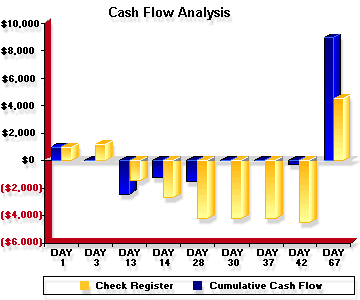| Case
Study — The Cash Flow Gap
This example shows how easily a cash flow gap can occur in a small business. A cash flow gap is a shortage of cash caused by the mismatching of cash outflows and cash inflows. John makes custom furniture for professional decorators and furniture retail shops. In addition to himself, John has two other employees. John pays himself and his employees every other week (bi-weekly). When a customer places an order for a piece of furniture, John receives a 10 percent down payment of the total sales price. The customer is then billed for the remainder of the sale after the furniture is completed and delivered. The total sales price of a recently ordered dining room set is $10,000. The material needed for this job is priced at $2,500 and will come from one supplier. This supplier offers a 2 percent discount if John pays for the supplies within 10 days after receiving them. John always takes advantage of early payment discounts. The following graphic, illustrating the cash flow effects of the sale from start to finish, will help you identify John's cash flow gap. (Click on each of the blue or yellow bars to see a detailed explanation of business events affecting John's cash flow each week.)
Breaking down the sale of the dining room set, and tracing it step-by-step through the cash flow, identifies John's cash flow gap. In John's case, a cash flow gap starts on day 13 and continues to grow, reaching $4,450 just prior to collecting the customer's account. Although this example has been simplified, it's typical of the cash flow gap that occurs in many small businesses. The cash flow gap creates the need for effective cash
flow management. Effective cash flow management can help
reduce the amount of time between John's cash inflows and cash
outflows. This in turn, will help reduce or close John's cash
flow gaps. |
